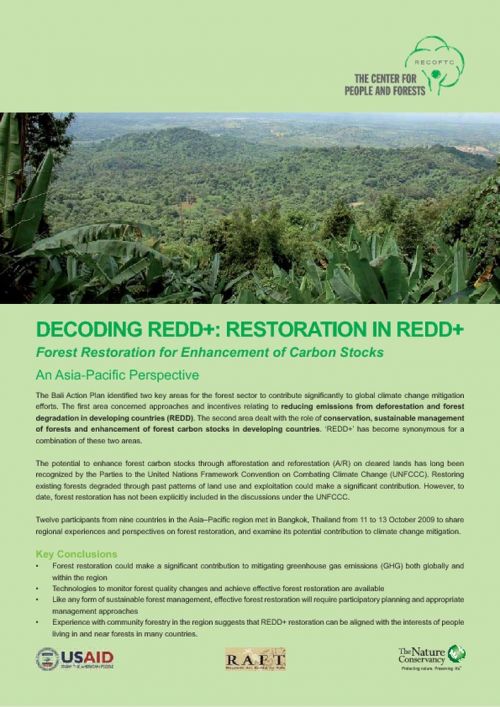APA 6th ed. Decoding REDD: Forest Restoration in REDD+. (2009, October 31). Retrieved from https://www.recoftc.org/publications/0000021
MLA 8th ed. Decoding REDD: Forest Restoration in REDD+. RECOFTC, 31 October 2009, https://www.recoftc.org/publications/0000021.
Chicago 17th ed. RECOFTC. 2009. "Decoding REDD: Forest Restoration in REDD+." Published October 31, 2009. https://www.recoftc.org/publications/0000021.
Decoding REDD: Forest Restoration in REDD+

The Bali Action Plan identified two key areas for the forest sector to contribute significantly to global climate change mitigation. One area concerned approaches and incentives relating to reducing emissions from deforestation and forest degradation in developing countries (REDD). The second area focused on the role of conservation, sustainable management of forests and enhancement of forest carbon stocks in developing countries. REDD+ has become synonymous for a combination of these two areas.
The potential to enhance forest carbon stocks through afforestation and reforestation (A/R) on cleared lands has long been recognized by the Parties to the United Nations Framework Convention on Combating Climate Change (UNFCCC). Restoring existing forests degraded through past patterns of land use and exploitation could also make a significant contribution. However, to date, forest restoration has not been explicitly included in UNFCCC discussions.
Twelve participants from nine countries in the Asia-Pacific region met in Bangkok, Thailand from 11 to 13 October 2009 to share regional experiences and perspectives on forest restoration, and examine its potential contribution to climate change mitigation.
Key Conclusions
- Forest restoration could make a significant contribution to mitigating greenhouse gas emissions (GHG) both globally and within the region
- Technologies to monitor forest quality changes and achieve effective forest restoration are available
- Like any form of sustainable forest management, effective forest restoration will require participatory planning and appropriate management approaches
- Experience with community forestry in the region suggests that REDD+ restoration can be aligned with the interests of people living in and near forests in many countries.

